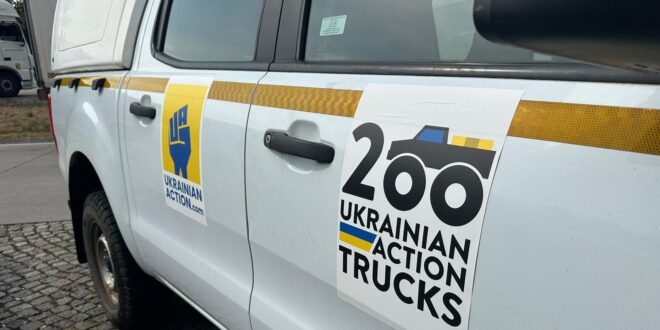One of many crowdfunded initiatives that have sprouted up to help Ukraine since Russia’s invasion, Ukrainian Action has just delivered its 200th vehicle filled with humanitarian supplies.
The conflict in Ukraine has come to be known as the “crowdfunded war”, as volunteers from around the world use social media to raise money to buy everything from missiles and drones to tanks and ambulances to aid the resistance against the Russian invaders.
One such group is Ukrainian Action, which over the weekend of July 22-23 delivered its 200th vehicle, filled with humanitarian supplies, on its 40th run from London to Lviv since the war began in February 2022.
The brainchild of American-born Jeff Hartman, who lives in London with his Ukrainian wife, the UK Charity Commission- and US-registered 501c3 non-profit uses Hartman’s network of friends in Ukraine and Poland to send convoys of usually between five and 11 trucks across the Channel Tunnel into France, then through Germany and Poland to the border, where they are picked up by Ukrainian volunteers who split up the supplies and deliver the trucks to where they have been promised.
In the five-truck convoy that BIRN joined, one of the vehicles was destined for an orphanage in southwest Ukraine that looks after children displaced by the war; another was to be sent to a medical unit that facilitates civilian evacuations; yet another to a charity that assists in treating veterans with PTSD.
These trucks, like all others, were requested by type in advance by the Ukrainian volunteer networks and bought on the UK’s second-hand market by Ukrainian Action, which fully services the vehicles before they are driven to Ukraine.
The trucks serve three purposes, according to Hartman: as the main donation, the transporter of supplies, and as, literally, a PR vehicle. The trucks are emblazoned with Ukrainian Action’s eye-catching fist-raised logo (a graphic designer friend of Hartman’s came up with it), with this trip sporting specially designed 200th vehicle stickers.
The trucks elicited cheers and waves from passers-by, as well honks from another two vehicles belonging to a Norwegian charity also headed to Ukraine.
$3 million and counting
In terms of donations, Ukrainian Action has just passed the $3-million milestone from various sources, including via its website and the Just Giving pages of its volunteer drivers. Corporate donors have led to an interesting fundraising model, whereby companies like SalesForce and Knight Frank will make a donation, then send their staff on a run as part of their employee volunteer and team-building initiatives.
“That’s been a successful model, especially with companies looking for team-building interests – it’s much more adventurous than going on a pub quiz night,” says Hartman.
All the drivers are screened, often referred by others, and while former military and emergency service personnel are prized, others come from a variety of walks of life like bankers, management consultants and engineers. There is also a group of retirees from Devon. On BIRN’s run, there was the mayor of Oxford, Ohio looking to add Dubno to Luxembourg as a twin for his US city.
Drivers in the roster amount to over 250, up from the original two who made that first run in March 2022, with the NGO receiving two to three new applications per day.
“Above all, you have to be up for the cause, committed, ready for anything, a team player. And if you are mechanically inclined or speak a European language, that’s a plus,” Hartman tells BIRN while speeding along a highway in Poland at the rear of the convoy and, rather disconcertingly, juggling in his hands a two-way radio that allows communication between all the trucks.
Future projects
This is certainly not fair-weather volunteering, nor is it for the faint-hearted. It begins on a Friday afternoon packing the trucks, then driving in convoy for between 1,500 and 1,900 kilometres, depending on where you choose to get off and fly back to the UK. The trucks are rarely air-conditioned, not particularly designed for speeding down highways, and conditions in winter can be treacherous. There’s been no accidents, though some vehicles have broken down on the way and had to be repaired by local partners.
“We’re lucky in that we have a network of garages across Europe who will help us rescue any broken-down trucks and fix them,” says Hartman. “Some garages are run by the Ukrainian diaspora.”
For the future, Hartman doesn’t intend for the charity to end when the war eventually, mercifully ends. Having quit his day job two months ago to focus full time on Ukrainian Action, Hartman wants it to be part of the massive reconstruction effort that will be required afterwards.
“We started essentially in disaster relief supplying emergency vehicles. Hopefully, over time we won’t be needed for that, so we can focus more on longer-term development projects,” he says.
“We are already looking on a longer-tern perspective. Instead of sending diesel generators we are sending those that are solar powered, more in line with Ukraine’s future green transition. And we have sent grants to two local charities: one is repairing residential homes that have been destroyed in the Chernihiv region; the other provides free mental health care to women and children affected by the war across Ukraine,” he says.
 Eurasia Press & News
Eurasia Press & News




